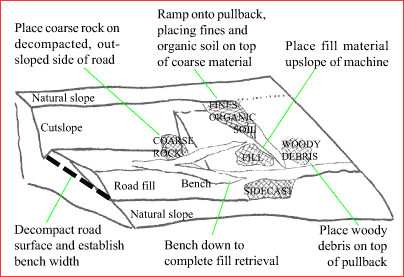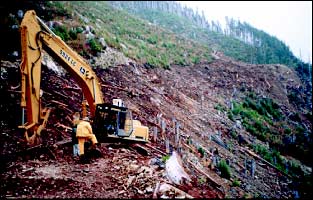|
Forest Road Deactivation Practices
|
|
in the Pacific Northwest
|


|
|
| 20 - Full Sidecast Pullback Practices
|
Pullback Placement, Sequence of Activities |
Full sidecast pullback may at times require benching, or moving ma-terial
along the road using multiple throws or endhaul. Safety must
be an overriding consideration under any circumstances. Benching
should only be done by experienced operators, only on native ground,
and with an escape route available at all times.
Figure 19: Machine Positioning and Pullback Placement

Suggested Sequence of Activities

- Decompact road surface and establish stable bench width.
- Start fill pullback and place material at top of cut. You can easily sort out your larger rocks and stones by releasing the material from your bucket up the slope. This will allow rocks to roll down the bench creating a rock blanket. If a subsurface blanket is created and significant water flow is expected, pull back all fill immediately below.
- If not all sidecast fill material can be reached and benching down is required, swing the road fill up to and on top of the rock which has been placed in the cut. If the bench is wide and this overburden cannot be swung to the top of the cut in one pass, you must ramp up to distribute the pullback correctly using multiple throws. Positioning the machine in a pattern resembling the letter Y makes the fill placement easier (see Figure 19).
- Finish the lower side by swinging the overburden upslope where it can be reached from above. Scatter woody debris over this lower, completed surface before moving. Place excess debris where it can be reached from the ramp above. When fill placement is complete, this debris can be reached and scattered, making sure that woody debris is on top of the recontoured slope. This will reduce surface erosion from rain and snow melt and facilitate the revegetation process.
- Ensure that pullback material is sealed tightly against cutbanks and well drained from beneath.
| 20 - Full Sidecast Pullback Practices
|
|
|
 20 Full Pullback Practices 20 Full Pullback Practices
|
©1999 - 2002 Flip Productions Limited
Used with permission by CulvertBC
|

